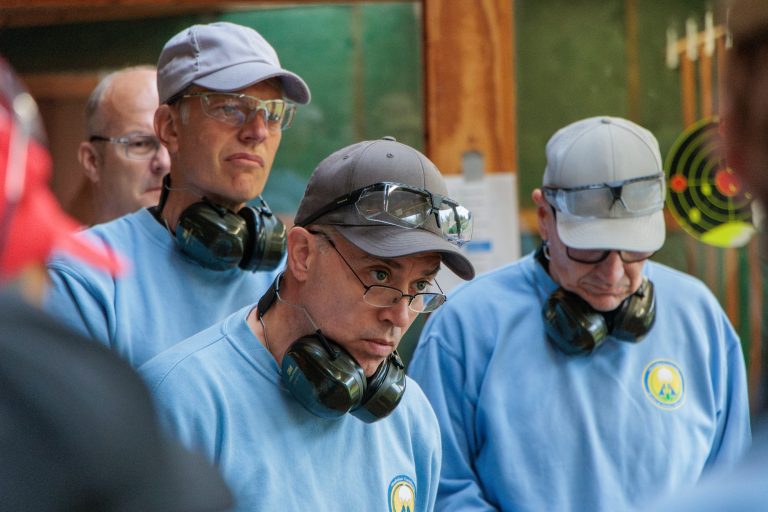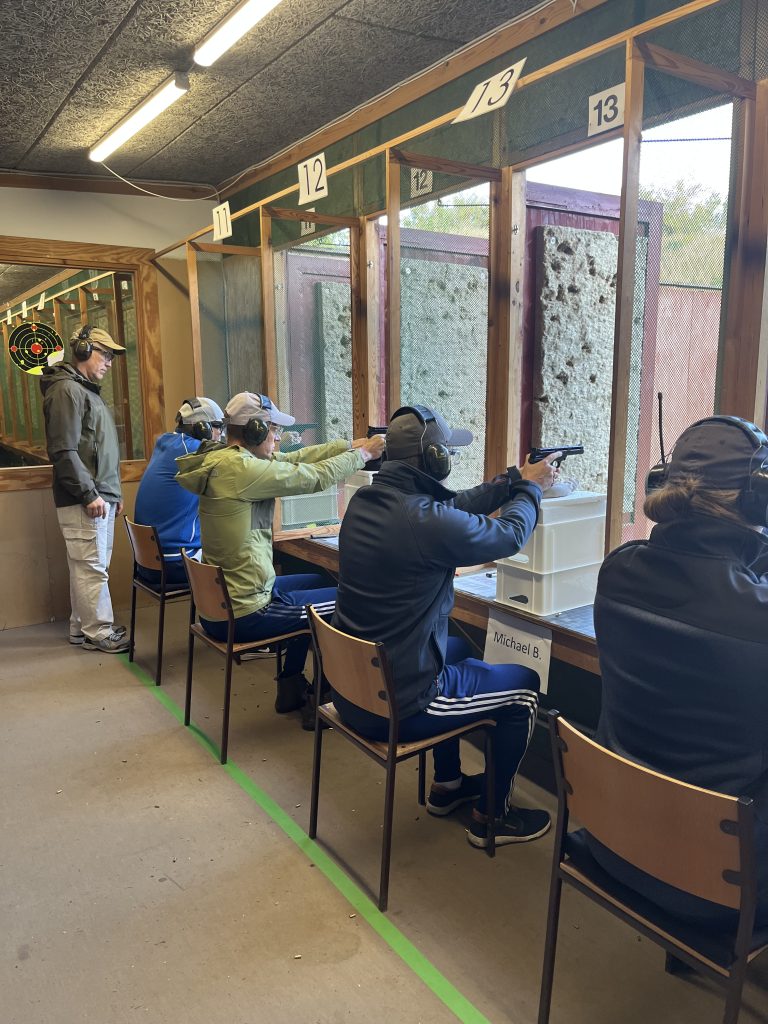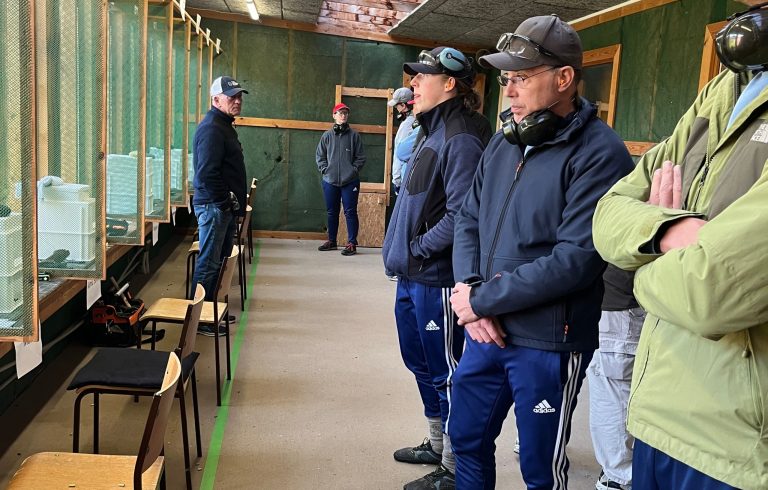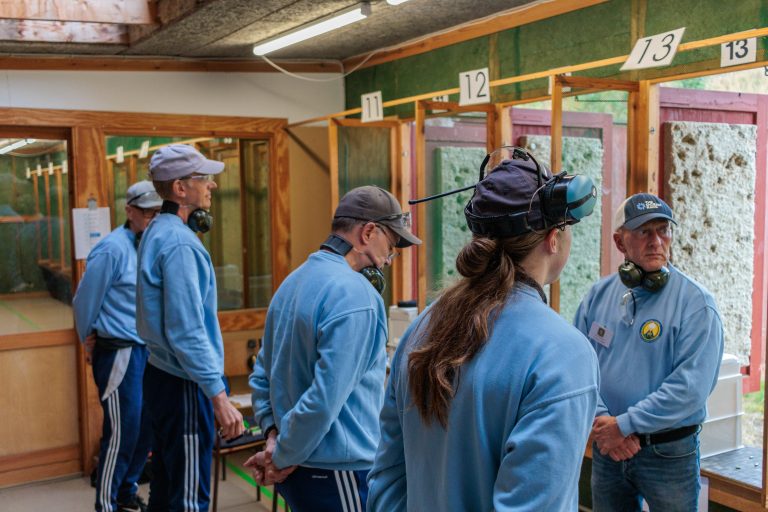
It was now time to complete and hopefully pass the third POMW course, where everything we had learned at POMW I & II should now be so much on the back burner that it could be effectively used in POMW III and further developed with the increasing degree of difficulty and new focal points for one's own attitude and self-knowledge under pressure.
The overall POMW III course is very concentrated and consists of 4 courses, each with their own focal points and learning, which is again divided into an individual and a community part. Each course lasts approx. 13½ hours, which means that great demands are placed on endurance and attitude so that you can keep focus 100% throughout the course. It is partly a question of safety, but also that you don't allow yourself to take a "slacker" and hit a little next to the black area on the target and think that next time I will do better - Every single ball counts and must frame in stain every time, just like when you fight, have to take an exam or close a big contract.
In addition, we now had to shoot on time so that we had 8 seconds to draw the gun, find the target and hit the "Bullseye" while doing it technically correctly (otherwise you won't hit the "Bullseye" at all!).
The POMW III course took place on an outdoor course and it was planned to shoot primarily with a 9mm pistol and caliber 0.22 as a kind of introduction and familiarization before it went loose with 9mm.
There had been a period of 5 weeks since the first part of POMW III where caliber 0.22 was primarily shot and we had to refresh the techniques in POMW I and II. Now we had reached the next stages and there we were asked to make a shooting support set-up which had to be adjustable in height and stable enough to support the weight of a shooting sock and a gun which just rested on the sock.
There were many exciting and creative solutions and fortunately they were all approved, but we were also a little excited about what such a setup would be used for!
We got this clarified by Kimu Sensei who told us that there are several parameters that can come into play as a source of error when you hit from the side. In addition to the five basic techniques:
- Correct Posture and double handle control
- Correct Breathing
- Correct Aim
- Correct Exhaust Control (Press'n squeeze)
- Correct Recoil Check and Aim
Then there is also the oscillation which plays a significant role - Oscillation is when the gun swings in a figure of 8 when you stand and aim. It only needs to be quite a bit, but the effect is quite large when the target is 25m or just 15m away.
So by using the line-up as a kind of support, commuting was taken out of the equation and thus you could focus on which technique(s) was the weakest link and what you had to focus on getting better at. It worked fantastically and very quickly you could see a marked improvement for all the POMW III shooters where the shots were now gathered in a cluster instead of being scattered across the target.
Once we had individually optimized the techniques that were the reason why the shots did not always hit where they were supposed to, namely in the middle of the disc, we switched to standing shooting and the commuting was again part of the potential sources of error. But now, on the other hand, we should be able to hit significantly better now that we knew which parameters had to be improved and incredibly, it also turned out that our shooting became much more stable and accurate.
In the subsequent courses, we had to become familiar with the 9mm pistol, as it is quite a bit more powerful than caliber 22 and it produced a proper bang when it was fired. Especially when you stand in a row and shoot, you can feel the sound pressure from the person next to you and that requires you to be able to abstract from it and stay focused. At the same time, the recoil is somewhat more violent and situations can arise where you are downright afraid of the recoil and this affects your performance in a rather negative direction. There it is important that you become "friends" with the gun and are familiar with the gun handling, then it starts to work and in fact I liked shooting with 9mm better than cal. 22 after a while.
At the POMW III course, it is taken for granted that you can handle the gun safely and correctly (however under the observation of the firing commanders) and that the basic shooting techniques are in place. Therefore, each round is shot with 30 shots with points each time, so that you can continuously see if your shooting improves after the major or minor corrections that you are told to change.
It is therefore also expected that you give your absolute best every time and that the results should be better. In addition, after a completed round we had to estimate how many points you had shot and they had to be within +/-10% of the points you had shot, otherwise the round would not apply and you would be registered for zero points. The same also applies if you did not shoot within the 8 second time frame for each shot. It wasn't what you wanted and therefore everything was done to do your best every time and preferably to do better - it showed that you had done what was said. Furthermore, we knew that our results and attitude were constantly being evaluated and would ultimately form the basis for whether we could pass POMWIII, so yes, there was pressure.
It also contributed to the fact that there was constant mental pressure and as you also got tired during the day, more energy had to be used to maintain mental focus. In addition, Kimu Sensei stood with an arsenal of loaded 9mm magazines and emptied them in record time while you stood and had to improve your performance in time and at the same time stay focused while empty and rather hot casings hit you in the head and arms. At the same time it gave some decent bangs and the pressure waves could be felt constantly both from the sideman and Kimu Sensei's machine gun volleys.
Despite the relatively great pressure, both psychologically and physically, I managed to collect my shots in a nice bunch, which meant that I was at the good end of the points scale. It therefore also became somewhat more demanding to improve my performance for each round and I really had to look at all the shelves inside my head where I could do better. It was a bit frustrating because when I looked over at Kimu Sensei's disc all his shots were in the middle of the disc despite him firing them in a fraction of the time we had available ourselves - So I concluded that there was base for improvement and I "just" had to dig a little deeper into myself and then get a lot of practice.
Despite the fact that it was a few very long days, the time passed incredibly quickly because we were constantly shooting or together with his comrades reviewed our experiences, experiences or shared good advice if we had made any observations that could be improved. But in addition to the practical part, there is the social part which consists of the usual completely unique Shindenkan togetherness even when we are all well marked after a long and mentally hard day or if there is just a friend who needs a pat on the back if the frustrations are taking over.
Absurdly delicious cakes were baked (and thank you for that, Helene 😊) which was a guarantee that everyone looked forward to the sparse breaks and that one's sugar level did not completely bottom out. Even cleaning the pistols, which took about 1½ hours, became downright fun with rock music and a lot of talking back and forth while the cleaning tool flew across the tables.
So after the first three courses in POMW III had been completed and we could look back on some hard but educational and fun hours, the hour of truth had come when we were told whether we had passed or not because it was absolutely not a foregone conclusion. Fortunately, I passed the first part, which was the individual part of the course and then there was the last course where the community part had to be passed.
In connection with the individual part, Kimu Sensei had decided that I and another person should be further trained as assistant shooting instructor/commander under SDKSKYT auspices so that we could contribute to future POMW courses. It was obviously a great recognition and it meant that me and my friend's course was not quite over yet.
The last part, for our part, consisted of working together with the trained instructors and solving various tasks that were related to the role of the firing commander and which were continuously assessed to see if we had the necessary overview and at the same time could ensure that safety was prioritized . There was less shooting this day as we had to focus on the tasks we were given.
This day also went just as quickly as the other days and when the day was over, we could look back on an exciting and educational day from the instructors' point of view and it was definitely a big responsibility to live up to that we are responsible for the safety of our comrades and that they do not get hurt or worse.
I still don't know if we passed, we have that to our credit as our efforts must be assessed by Kimu Sensei, but until then I can only say that it has been a super exciting course which has given me a great insight into getting to know myself and that practice makes perfect - throughout life 😊
























